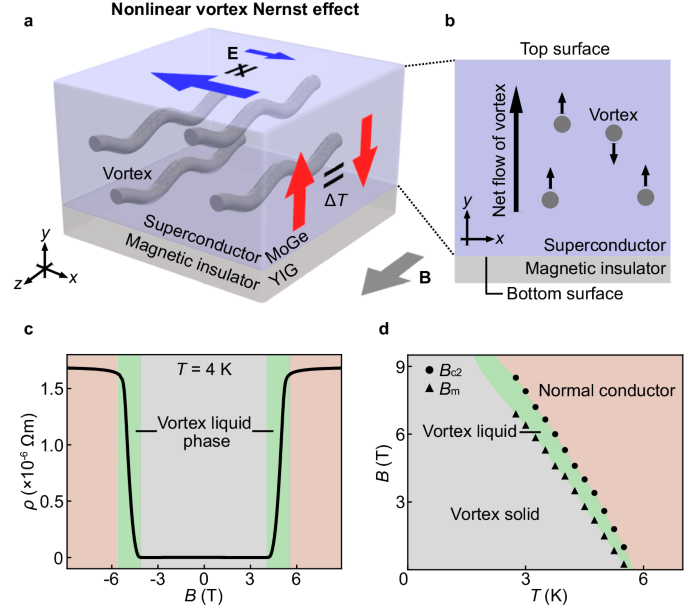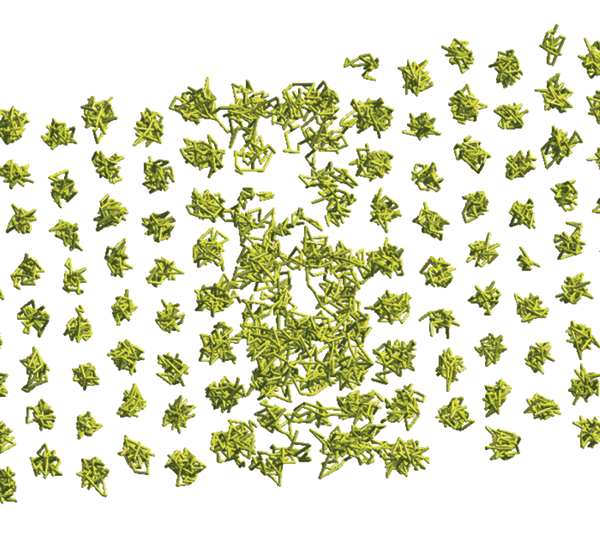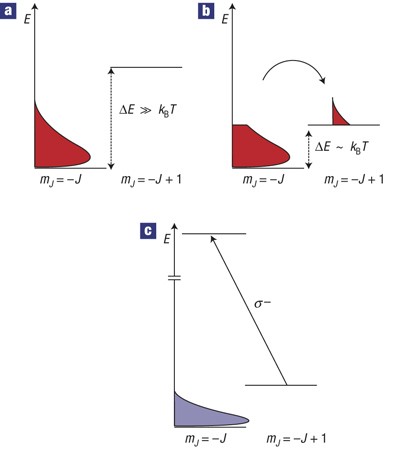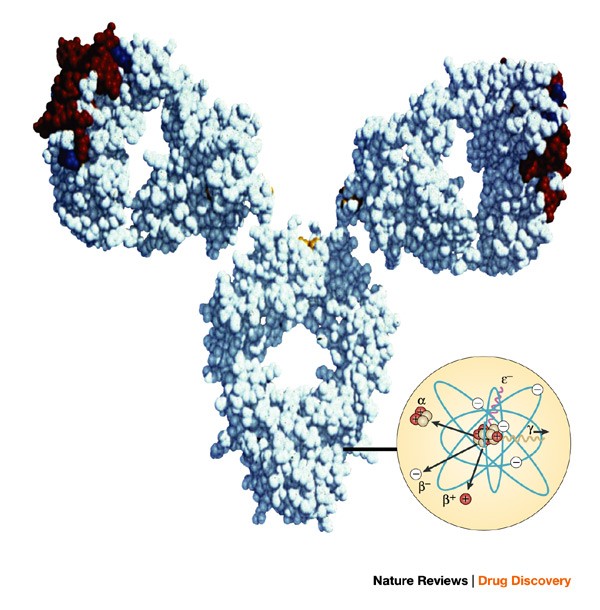
- Select a language for the TTS:
- UK English Female
- UK English Male
- US English Female
- US English Male
- Australian Female
- Australian Male
- Language selected: (auto detect) - EN
Play all audios:
ABSTRACT Thermoelectric effects refer to the voltage generation from temperature gradients in condensed matter. Although various power generators are made from them, all the known effects,
such as Seebeck effect, require macroscopic temperature gradients; since the sign of the generated voltage is reversed by reversing the temperature gradient, the net voltage disappears when
the temperature distribution fluctuates temporarily or spatially with a macroscopic temperature gradient of zero. It is impossible to utilize such temperature fluctuations in the
conventional thermoelectric effects, a situation which limits their application. Here we report the observation of a second-order nonlinear thermoelectric effect; we develop a method to
measure nonlinear thermoelectricity and observe that a superconducting MoGe film on Y3Fe5O12 generates a voltage proportional to the square of the applied temperature gradient. The nonlinear
thermoelectric generation demonstrated here provides a way for making power generators that produce electric power from temperature fluctuations. SIMILAR CONTENT BEING VIEWED BY OTHERS
BIPOLARITY OF LARGE ANOMALOUS NERNST EFFECT IN WEYL MAGNET-BASED ALLOY FILMS Article 08 January 2024 ROOM-TEMPERATURE NONLINEAR TRANSPORT AND MICROWAVE RECTIFICATION IN ANTIFERROMAGNETIC
MNBI2TE4 FILMS Article Open access 19 December 2024 MAGNETO-OPTICAL DESIGN OF ANOMALOUS NERNST THERMOPILE Article Open access 27 May 2021 INTRODUCTION Typical thermoelectric effects
established so far are Seebeck effect1 and Nernst effect2. Seebeck effect refers to the voltage generation along the temperature gradient, while Nernst effect refers to the voltage
generation normal to the gradient. In both, the amplitude of the generated voltage is proportional to that of the temperature gradient, and disappears in the absence of macroscopic
temperature gradients of a scale larger than the sample size. Here we report the observation of second-order nonlinear thermoelectric voltages, whose amplitude is proportional to the square
of the temperature gradient. To explore the nonlinear thermoelectric effect, a superconductor molybdenum-germanium (MoGe) on a magnet is a useful materials system3. It is a typical system
showing nonlinear resistance that can be controlled by using magnetic fields. In MoGe, a superconducting vortex-liquid state appears4,5 (see the phase diagram in Fig. 1d, determined6 based
on the resistivity measurement), in which a vortex, a string-shaped defect of superconductivity, can easily move by applying a current. The vortex motion driven by a current induces temporal
changes in the local phase of the superconducting wave function around the vortex core and gives rise to the electromotive force due to the phase change. Therefore, the vortex liquid phase
exhibits finite resistance in spite of its superconductivity7 (see Fig. 1c). In MoGe films on a ferrimagnetic insulator Y3Fe5O12 (YIG), the in-plane vortex resistance is externally nonlinear
with respect to the current when a magnetic field is applied in the in-plane direction3. The nonlinear resistance has been attributed to the asymmetry of magnetic fluctuations between the
top and bottom surfaces of the MoGe film (Fig. 1b), which causes different vortex nucleation rates8 (Bean-Livingston barriers) between the surfaces and gives rise to different resistance
depending on the vortex flow directions. The field-induced transition to the vortex liquid phase is so sharp that this nonlinear resistance can be turned on and off by changing the fields,
an advantage which realizes controllable experiments. By using this materials system, as shown in Fig. 1a, b, we investigate a nonlinear thermoelectric effect, where the thermoelectric
voltage due to the vortex Nernst effect9 becomes nonlinear with respect to the temperature difference. RESULTS SAMPLE AND MEASUREMENT SETUP The key for sensitively measuring a thermoelectric
effect is the use of higher-harmonic lock-in methods10,11. In conventional linear thermoelectric measurement, an a.c. current, \(I\sin \omega t\), is applied to a heater attached to an end
of the sample while the other end is connected to a heat bath. Since the Joule heating is proportional to the square of the applied current, the temperature difference ∆_T_ across the sample
is proportional to \({I}^{2}{\sin }^{2}\omega t\propto \cos 2\omega t+{{{{\rm{constant}}}}}\). Therefore, the linear thermoelectric voltage (\(\propto\) ∆_T_) temporally oscillates at 2_ω_,
which can be sensitively detected by a 2_ω_ lock-in method using the a.c. current as a reference. Then, how can we measure the nonlinear thermoelectric voltage proportional to (∆_T_)2
sensitively? One might think that a similar 4_ω_ lock-in method could be used, since the nonlinear thermoelectric voltage \([\propto {\left(\Delta T\right)}^{2}]\propto
{I}_{{{{{\rm{H}}}}}}^{4}\), where _I_H refers to the current applied to the heater and \(\Delta T\propto {I}_{{{{{\rm{H}}}}}}^{2}\). However, we found that the 4_ω_ lock-in method does not
work properly, because the 4_ω_ harmonic component is contaminated by the multiplication of linear thermoelectric responses (\(\propto {I}_{{{{{\rm{H}}}}}}^{2}\)); the order of the lock-in
detection should be carefully chosen for reliable measurement (see Methods for details). Here we have developed a second-order lock-in method to measure the nonlinear thermoelectric
voltages. First, two heaters are attached to both ends of the sample (Fig. 2d). Then, a.c. currents with the same frequency \(\omega /2\pi\) are applied to the heaters, superimposed with
d.c. currents. Owing to the d.c. currents, the heat generated at each heater contains a 1_ω_-oscillating component as an a.c.-d.c. cross term as well as a 2_ω_-oscillating component. The
values of the heater currents are tuned so that the same amount of heat is generated from the two heaters (see Methods for details). When the phase difference \(\phi\) between these heater
currents is zero, an identical amount of heat is generated at the two heaters all the time, and the temperature difference across the sample is kept zero. This condition can be confirmed by
the disappearance of the thermoelectric voltage at 1_ω_ and 2_ω_. After establishing the condition, the relative phase _ϕ_ between the heater currents is displaced from zero. When _ϕ_ = _π_,
the two heaters are heated alternately at 1_ω_ (the 2_ω_-oscillating temperature difference remains zero since 2_ϕ_ = 2_π_), and the temperature difference oscillating at 1_ω_ finally
appears across the sample without 2_ω_ components. The second-order nonlinear thermoelectric effect converts this 1_ω_ temperature difference into a 2_ω_-oscillating voltage, which can be
detected in terms of the 2_ω_ lock-in method by using the heater current as a reference. The expected _ϕ_ dependence of this 2_ω_ lock-in voltage V2_ω_ is (see Fig. 2a, b, and Supplementary
Note 1) $${V}_{2\omega }\propto \,\cos \phi {\sin }^{2}\left(\frac{\phi }{2}\right).$$ (1) This characteristic dependence provides a touchtone for discriminating nonlinear thermoelectric
effects. Figure 2c shows a schematic illustration of the sample system used in the present study. The sample is an amorphous MoGe film with the thickness 150 nm, sputtered on YIG. YIG
exhibits large magnetic susceptibility, resulting in a difference in the electromagnetic fluctuation amplitude between the top and bottom surfaces of the MoGe3. To apply ∆_T_ along the _y_
axis, the sample was sandwiched by two heaters (Fig. 2d). Following the above procedure, we measured the second harmonic lock-in voltage V2_ω_ along the \(x\) axis between the electrodes
(Fig. 2c, d) using the current \({I}_{{{{{\rm{H}}}}}1}\sin (\omega t+\phi )\) applied to the Heater-1 as a reference. We also applied the current \({I}_{{{{{\rm{H}}}}}2}\sin \omega t\) to
the Heater-2. Here \(\phi\) is the phase difference between the two heater currents. We define the normalized second harmonic voltage as \(\Delta {V}_{2\omega }={V}_{2\omega }\left(\phi
\right)-{V}_{2\omega }\left(\phi+\pi \right)\). OBSERVATION OF NONLINEAR THERMOELECTRIC EFFECT In Fig. 2e, we show the second harmonic voltage \(\Delta {V}_{2\omega }\) measured for the
YIG/MoGe at \(4.43\) K and \(\phi=\pi\) (blue solid curve), a condition where the \(1\omega\)-oscillating temperature difference across the sample is maximized. Importantly, a clear \(\Delta
{V}_{2\omega }\) signal appears at \(3\) T \( < {|B|} \, < \, 4\) T. This field range coincides with the appearance condition for the superconducting vortex-liquid phase in the MoGe
at the present temperature (see the resistivity \(\rho\) in Fig. 2e), signaling that the second-harmonic nonlinear signal \(\Delta {V}_{2\omega }\) appears only when vortices are mobile.
Figure 2f shows the \(\phi\) dependence of \({V}_{2\omega }\) measured with the fixed magnetic field \(B=-3.75\) T at \(T=4.34\) K. With the change in \(\phi\), \({V}_{2\omega }\) exhibits
complicated oscillation. The observed \(\phi\) dependence is in perfect agreement with the characteristic behavior, predicted for the nonlinear thermoelectric effect as Eq. (1) (see Fig. 2b,
f). By tuning the phase \(\phi\) to \(\phi=2\pi\), at which the temperature difference generated by the heaters is absent, the value of \({V}_{2\omega }\) decreases to \(\sim 0\), showing
that the observed \({V}_{2\omega }\) signal is caused by the temperature difference generated in the sample, not by the simple heating of the sample. The absence of the \({V}_{2\omega }\)
signal in a MoGe/SiO2 sample also shows that the influence of the sample heating is negligibly small (see Supplementary Note 3 for details). All these are evidence that the observed
\({V}_{2\omega }\) signal is the second-order nonlinear thermoelectric voltage caused by vortex motion. Note that the \({V}_{2\omega }\) picks up the second-order response with respect to
the temperature difference (see Supplementary Note 4 for details). The \({V}_{2\omega }\) signal disappears (gray dots in Fig. 2f) when the system temperature is higher than the transition
temperature of the superconductivity, \({T}_{{{{{\rm{c}}}}}}\), supporting the interpretation. We also confirmed that the spatial temperature inhomogeneity is small along the sample length
(see Supplementary Note 6 and 7 for details), and confirmed that the \({V}_{2\omega }\) signal appears at different values of \(\omega /2{{{{\rm{\pi }}}}}\) (see Supplementary Note 9 for
details). In Fig. 3a, we show the heater-current amplitude \({I}_{{{{{\rm{H}}}}}}\) dependence of \({V}_{2\omega }\) for the YIG/MoGe. By increasing \({I}_{{{{{\rm{H}}}}}}\) from \(0.35\) mA
to \(3.25\) mA, the \({V}_{2\omega }\) signal proportional to \(\cos \phi {\sin }^{2}\left(\phi /2\right)\) becomes more distinct with the peak amplitude \({A}_{2\omega }\). In Fig. 3b, we
plot the \({A}_{1\omega }\) dependence of \({A}_{2\omega }\), where \({A}_{1\omega }\) refers to the peak amplitude of the \(1\omega\) linear thermoelectric voltage, measured simultaneously
by using the lock-in method. The linear thermoelectric voltage is proportional to the temperature gradient applied to the sample. The data in Fig. 3b shows that \({A}_{2\omega }\) is
proportional to \({A}_{1\omega }^{2}\), demonstrating that the observed second harmonic voltage is proportional to the square of the applied temperature gradient. Figure 3c shows the
temperature \(T\) dependence of \(\Delta {V}_{2\omega }\) for the YIG/MoGe at \(\phi=\pi\). With the increase in \(T\) from \(3.54\) K, the \(\Delta {V}_{2\omega }\) peak shifts to lower
fields (blue solid curves in Fig. 3c). The field dependence of the resistivity \(\rho\) of the sample at each \(T\) is shown as the red solid curves in Fig. 3c, which shows that the \(\Delta
{V}_{2\omega }\) peaks appear concomitant with the sudden change in \(\rho\) signaling the appearance of the vortex liquid state at each temperature. The results support our interpretation
that the second harmonic voltage is due to the vortex motion in the vortex liquid phase in the MoGe/YIG. PHENOMENOLOGICAL MODEL FOR NONLINEAR VORTEX NERNST EFFECT We formulated the nonlinear
vortex Nernst effect in the MoGe/YIG in terms of a phenomenological model3. In the model, we assume that the vortex flow \({{{{{\bf{J}}}}}}_{{{{{\rm{v}}}}}}(+\Delta T)\) in the \(-{{y}}\)
direction [\({{{{{\bf{J}}}}}}_{{{{{\rm{v}}}}}}\left(-\Delta T\right)\) in the \(+{{{y}}}\) direction] due to the temperature difference \(\Delta T\) \([-\Delta T]\) is governed by the
nucleation process12,13 of vortex strings at the interfaces of the MoGe (Fig. 4a). The vortex nucleation rate \(\propto {e}^{-\Delta F/{k}_{{{{{\rm{B}}}}}}T}\) is determined by the
nucleation energy barrier \(\Delta F\) of a vortex at the interface14, where \({k}_{{{{{\rm{B}}}}}}\) is the Boltzmann constant. The energy barrier \({\Delta F}_{{{{{\rm{YIG}}}}}}\) at the
MoGe/YIG interface is less than that at the opposite interface, \({\Delta F}_{{{{{\rm{vac}}}}}}\), since the greater magnetic susceptibility in YIG reduces the magnetostatic energy of the
stray field created in the YIG by a nucleated vortex3 (see Supplementary Note 2). The asymmetry of the energy barrier, \({\Delta F}_{{{{{\rm{YIG}}}}}} \, < \, {\Delta
F}_{{{{{\rm{vac}}}}}}\), induces a difference in the vortex nucleation rate between the interfaces under \(\Delta T\), and leads to an asymmetric thermal vortex flow
\(|{{{{{\bf{J}}}}}}_{{{{{\rm{v}}}}}}(+\Delta T)|\ \ne \ |{{{{{\bf{J}}}}}}_{{{{{\rm{v}}}}}}\left(-\Delta T\right)|\) (Fig. 4a). The asymmetric vortex flow generates an electric field
according to \({{{{\bf{E}}}}}\propto {{{{\bf{B}}}}}\times {{{{{\bf{J}}}}}}_{{{{{\rm{v}}}}}}\), giving rise to the vortex Nernst effect proportional to \({\left(\Delta T\right)}^{2}\): a
nonlinear vortex Nernst effect. We calculated the electric field due to the nonlinear vortex Nernst effect as (see Methods and Supplementary Note 2 for details)
$${E}_{{{{{\rm{N}}}}}2}\propto \frac{{S}_{\phi }}{\eta d}\left(\frac{\Delta {F}_{{{{{\rm{YIG}}}}}}}{{k}_{{{{{\rm{B}}}}}}T}{e}^{-\frac{\Delta
{F}_{{{{{\rm{YIG}}}}}}}{{k}_{{{{{\rm{B}}}}}}T}}-\frac{\Delta {F}_{{{{{\rm{vac}}}}}}}{{k}_{{{{{\rm{B}}}}}}T}{e}^{-\frac{\Delta
{F}_{{{{{\rm{vac}}}}}}}{{k}_{{{{{\rm{B}}}}}}T}}\right){\left(\Delta T\right)}^{2},$$ (2) where \({S}_{\phi }\), \(\eta\), and \(d\) are the entropy carried by a vortex, the vortex viscosity,
and the thickness of the MoGe film, respectively. In Fig. 4c, we show the \(B\) dependence of \({E}_{{{{{\rm{N}}}}}2}\) calculated from Eq. (2), which reproduces the experimental data (see
Fig. 4b). The measurement method presented here will allow the exploration of nonlinear thermoelectric effects in various candidate materials, such as bilayer conductors that exhibit
nonreciprocal resistance15 and polar ferromagnetic conductors16. The nonlinear thermoelectric effect can be used for making temperature-fluctuation sensors and voltage generators using
out-of-equilibrium temperature fluctuations. The effect also bridges a gap between thermoelectricity and nonlinear physics in a solid. It will certainly be important to find matter that
exhibits the effect at room temperature. METHODS SAMPLE PREPARATION A Y3Fe5O12 (YIG) film with the thickness \(\sim\)1 μm was grown on a Gd3Ga5O12 (GGG) (111) substrate with the thickness
520 μm by liquid phase epitaxy. An amorphous MoGe film with the thickness 150 nm was sputtered on the YIG by RF sputtering in the Argon atmosphere of 2.8 × 10−1 Pa. During the sputtering,
the substrate was rotated at 3000 rpm and kept at room temperature by water cooling17. The length and the width of the MoGe/YIG sample are 8.0 mm and 1.0 mm, respectively. MEASUREMENT SETUP
FOR NONLINEAR VORTEX NERNST EFFECT The measurement was performed by a standard lock-in technique10,11 using Physical Property Measurement System (Quantum Design, Inc.). When a temperature
difference, ∆_T_, is applied to a material, the generated thermoelectric voltage _V_ can be expanded as \(V={a}_{1{{{{\rm{st}}}}}}\Delta T+ {a}_{2{{{{\rm{nd}}}}}}{\left(\Delta
T\right)}^{2}+\cdots\), where \({a}_{n{{{{\rm{-th}}}}}}\ (n={{{\mathrm{1,\ 2}}}}, \cdots )\) is the \(n\)-th order thermoelectric coefficient. When the input temperature difference
oscillates at the frequency \(\omega /2\pi\), the _n_-th harmonic voltage detected with a lock-in amplifier is given by \({V}_{n{\omega }}\left(t\right)=\frac{1}{{t}_{0}}{\int
}_{t-{t}_{0}}^{t} \sin \left(n{\omega }{t}^{{\prime} }+ {\theta }_{0}\right)V\left(t^{\prime} \right){dt}^{\prime},\) where \({t}_{0}\) is a sufficiently large averaging time and \({\theta
}_{0}\) is a set phase for the amplifier. In conventional linear thermoelectric measurement, a temperature difference is generated via the Joule heating induced by the a.c. current
\(\propto\) sin _ωt_ applied to a heater attached to an end of the sample, \(\Delta T\propto {\sin }^{2}\omega t\), and the \(2\omega\) lock-in voltage is measured. Similarly, one might
think that a nonlinear thermoelectric effect \(\propto {\left(\Delta T\right)}^{2}\) can be measured via the 4_ω_ lock-in measurement. However, the 4_ω_ lock-in signal may include not only
the second harmonic response but also the third harmonic one which may appear even without inversion symmetry breaking. To address this issue, the order of the lock-in detection should be
lowered, which is achieved if the input temperature difference oscillates in a first-harmonic manner, \(\Delta T\propto \sin \omega t\). To create \(\Delta T\propto \sin \omega t\) and
detect the second-order nonlinear thermoelectric voltage selectively, two heaters (Heater-1 and Heater-2) were attached to the MoGe and GGG surfaces, respectively (Fig. 2d). The currents
\({I}_{{{{{\rm{H}}}}}1}\sin (\omega t+\phi )+{I}_{{{{{\rm{DC}}}}}1}\) and \({I}_{{{{{\rm{H}}}}}2}\sin \omega t+{I}_{{{{{\rm{DC}}}}}2}\) were applied to the Heater-1 and the Heater-2,
respectively. Due to the Joule heating, ∆_T_ is generated in the MoGe film along the thickness direction (_y_ direction in Fig. 2c, d): $$\Delta T= \, {R}_{1}{\left[{I}_{{{{{\rm{H}}}}}1}\sin
(\omega t+\phi )+{I}_{{{{{\rm{DC}}}}}1}\right]}^{2}-{{R}_{2}\left({I}_{{{{{\rm{H}}}}}2}\sin \omega t+{I}_{{{{{\rm{DC}}}}}2}\right)}^{2}\\= \,
{\widetilde{I}}_{{{{{\rm{DC}}}}}1}^{2}-{\widetilde{I}}_{{{{{\rm{DC}}}}}2}^{2}+2{\widetilde{I}}_{{{{{\rm{DC}}}}}1}{\widetilde{I}}_{{{{{\rm{H}}}}}1}\sin (\omega t+\phi
)-2{\widetilde{I}}_{{{{{\rm{DC}}}}}2}{\widetilde{I}}_{{{{{\rm{H}}}}}2}\sin \omega t \\ + {\widetilde{I}}_{{{{{\rm{H}}}}}1}^{2}{\sin }^{2}\left(\omega t+ \phi
\right)-{\widetilde{I}}_{{{{{\rm{H}}}}}2}^{2}{\sin }^{2}\omega t.$$ (3) Owing to the a.c. and d.c. currents, the resultant temperature difference contains the 1\(\omega\)-oscillating
components as the a.c.-d.c. cross terms. Here, \({R}_{1}\) (\({R}_{2}\)) represents the prefactor relating the Joule heating of the Heater-1 (Heater-2) to \(\Delta T\), and
\({\widetilde{I}}_{{{{{\rm{H}}}}}1,{{{{\rm{DC}}}}}1}\) (\({\widetilde{I}}_{{{{{\rm{H}}}}}2,{{{{\rm{DC}}}}}2}\)) is defined as
\({{\widetilde{I}}^{2}}_{{{{{\rm{H}}}}}1,{{{{\rm{DC}}}}}1}={R}_{1}{I}_{{{{{\rm{H}}}}}1,{{{{\rm{DC}}}}}1}^{2}\)
(\({{\widetilde{I}}^{2}}_{{{{{\rm{H}}}}}2,{{{{\rm{DC}}}}}2}={R}_{2}{I}_{{{{{\rm{H}}}}}2,{{{{\rm{DC}}}}}2}^{2}\)). Before the measurement of the nonlinear vortex Nernst voltage, the values of
\({I}_{{{{{\rm{DC}}}}}1}\), \({I}_{{{{{\rm{DC}}}}}2}\), \({I}_{{{{{\rm{H}}}}}1}\), and \({I}_{{{{{\rm{H}}}}}2}\) were tuned so that the same amount of heat is generated from the two heaters
when \(\phi=0\), which is realized under \({\widetilde{I}}_{{{{{\rm{DC}}}}}1}={\widetilde{I}}_{{{{{\rm{DC}}}}}2}={\widetilde{I}}_{{{{{\rm{DC}}}}}}\) and
\({\widetilde{I}}_{{{{{\rm{H}}}}}1}={\widetilde{I}}_{{{{{\rm{H}}}}}2}={\widetilde{I}}_{{{{{\rm{H}}}}}}\) (see Supplementary Note 1 for the detailed procedure). When the relative phase
\(\phi\) between the heater currents is changed from \(0\) to \(\pi\), the two heaters are heated alternately at \(1\omega\), and the temperature difference oscillating at \(1\omega\) is
produced across the sample without \(2\omega\) components: \(\Delta T\propto \sin \omega t\). The validity of this method is confirmed by measuring the generated temperature gradient with
film-thermometers attached to the sample or by measuring the Nernst effect for a reference Permalloy sample (see Supplementary Notes 7 and 8 for details). The nonlinear vortex Nernst effect
converts this \(1\omega\) temperature gradient into a \(2\omega\)-oscillating transverse voltage \(\propto {\left(\nabla T\right)}^{2}\), and the 2\(\omega\) lock-in voltage \({V}_{2\omega
}^{2{{{{\rm{nd}}}}}}\) should exhibit a characteristic \(\phi\) dependence: $${V}_{2\omega }^{2{{{{\rm{nd}}}}}}\propto {a}_{2{{{{\rm{nd}}}}}}\cos \phi {\sin }^{2}\left(\frac{\phi
}{2}\right),$$ (4) which is different from the \(2\omega\) “linear” vortex Nernst voltage \({V}_{2\omega }^{1{{{{\rm{st}}}}}}\) arising from the fifth and sixth terms in Eq. (3):
$${V}_{2\omega }^{1{{{{\rm{st}}}}}}\propto {a}_{1{{{{\rm{st}}}}}}{\sin }^{2}\phi .$$ (5) This shows that the nonlinear thermoelectric voltage can be distinguished from the conventional
linear thermoelectric voltage in terms of the \(\phi\) dependence of \({V}_{2\omega }\). In the experiments, the second harmonic lock-in voltage \({V}_{2\omega }\) in the MoGe in the \(x\)
direction is measured with a lock-in amplifier (LI5640, NF Corporation) by using the Heater-1 current \({I}_{{{{{\rm{H}}}}}1}\sin \left(\omega t+\phi \right)\) as a reference. All the
\({\Delta V}_{2\omega }\)-\(B\) and \({V}_{2\omega }\)-\(\phi\) data were anti-symmetrized with respect to the magnetic field \(B\). PHENOMENOLOGICAL MODEL FOR NONLINEAR VORTEX NERNST EFFECT
We consider a superconducting vortex system in a MoGe film attached to YIG. In the vortex liquid phase, vortex strings can move freely in the MoGe under a driving force. For simplicity, we
assume that the vortex flow is determined by the nucleation process of vortex strings at the MoGe surfaces3. The nucleation rate of a vortex is given by \(P\propto {e}^{-\Delta
F/{k}_{{{{{\rm{B}}}}}}T}\), where \(\Delta F\), \({k}_{{{{{\rm{B}}}}}}\), and \(T\) are the nucleation energy barrier of a vortex at the interface14, the Boltzmann constant, and temperature.
Since \(\Delta F\) is affected by the magnetic susceptibility in the vicinity of the MoGe surfaces and YIG exhibits the larger susceptibility than that of vacuum, the nucleation energy
barrier \({\Delta F}_{{{{{\rm{YIG}}}}}}\) at the MoGe/YIG interface is less than that at the opposite MoGe/vacuum interface, \({\Delta F}_{{{{{\rm{vac}}}}}}\), which results in the
difference in \(P\) between the top and bottom MoGe surfaces. In the presence of the temperature difference \(\Delta T\) (see Fig. 4a), vortex strings feel a thermal force,
\({{{{{\bf{f}}}}}}_{{{{{\rm{th}}}}}}={S}_{\phi }\Delta T/d(-{{{{{\bf{e}}}}}}_{y})\), where \({S}_{\phi }\), \(d\), and \((-{{{{{\bf{e}}}}}}_{y})\) are the entropy carried by a vortex, the
thickness of the MoGe film, and a unit vector along the \(y\) axis, respectively. This thermal force accelerates a vortex string to a speed \({{{{\bf{v}}}}}\), and the vortex string feels a
frictional force, \({{{{{\bf{f}}}}}}_{{{{{\rm{f}}}}}}=-\eta {{{{\bf{v}}}}}{{{{\boldsymbol{,}}}}}\) where \(\eta\) is the viscosity. In a steady state, the thermal force is in balance with
the frictional force, \({{{{{\bf{f}}}}}}_{{{{{\rm{th}}}}}}+{{{{{\bf{f}}}}}}_{{{{{\rm{f}}}}}}=0\), which leads to the terminal velocity of the vortex string
\({{{{{\bf{v}}}}}}_{{{{{\rm{v}}}}}}={S}_{\phi }\Delta T/\eta d(-{{{{{\bf{e}}}}}}_{y})\). When the temperature at the MoGe surface in contact with vacuum (YIG) is \(T+\Delta T/2\) (\(T-\Delta
T/2\)), the vortex flow \({{{{{\bf{J}}}}}}_{{{{{\rm{v}}}}}}(\Delta T)\) in the \(-y\) direction becomes finite. The amplitude \({J}_{{{{{\rm{v}}}}}}\left(\Delta T\right)\) of
\({{{{{\bf{J}}}}}}_{{{{{\rm{v}}}}}}(\Delta T)\) is described as $${J}_{{{{{\rm{v}}}}}}\left(\Delta T\right)\propto \left[{P}_{{{{{\rm{vac}}}}}}\left(T+\frac{\Delta
T}{2}\right)+{P}_{{{{{\rm{YIG}}}}}}\left(T-\frac{\Delta T}{2}\right)\right]\frac{{S}_{\phi }}{\eta }\frac{\Delta T}{d}.$$ (6) Here, \({P}_{{{{{\rm{vac}}}}}}(T)\propto {e}^{-{\Delta
F}_{{{{{\rm{vac}}}}}}/{k}_{{{{{\rm{B}}}}}}T}\) [\({P}_{{{{{\rm{YIG}}}}}}(T)\propto {e}^{-{\Delta F}_{{{{{\rm{YIG}}}}}}/{k}_{{{{{\rm{B}}}}}}T}\)] is the vortex nucleation rate at the
MoGe/vacuum [MoGe/YIG] interface. The vortex flow generates an electric field according to \({{{{\bf{E}}}}}\propto {{{{\bf{B}}}}}\times {{{{{\bf{J}}}}}}_{{{{{\rm{v}}}}}}\), and we calculate
the electric field due to the nonlinear vortex Nernst effect \(\propto {\left(\Delta T\right)}^{2}\) as $${E}_{{{{{\rm{N}}}}}2}\propto {\left.\frac{{\left(\Delta
T\right)}^{2}}{2}\frac{{\partial }^{2}}{\partial \Delta {T}^{2}}{J}_{{{{{\rm{v}}}}}}\left(\Delta T\right)\right|}_{\Delta T\to 0}.$$ (7) By substituting Eq. (6) into Eq. (7),
\({E}_{{{{{\rm{N}}}}}2}\) is expressed as (see Supplementary Note 2 for details) $${E}_{{{{{\rm{N}}}}}2}\propto \frac{{S}_{\phi }}{\eta d}\left(\frac{\Delta
{F}_{{{{{\rm{YIG}}}}}}}{{k}_{{{{{\rm{B}}}}}}T}{e}^{-\frac{\Delta {F}_{{{{{\rm{YIG}}}}}}}{{k}_{{{{{\rm{B}}}}}}T}}-\frac{\Delta {F}_{{{{{\rm{vac}}}}}}}{{k}_{{{{{\rm{B}}}}}}T}{e}^{-\frac{\Delta
{F}_{{{{{\rm{vac}}}}}}}{{k}_{{{{{\rm{B}}}}}}T}}\right){\left(\Delta T\right)}^{2}.$$ (8) DATA AVAILABILITY The data that support the findings of this study are available from the
corresponding author upon reasonable request. CODE AVAILABILITY The codes used in theoretical calculations are available from the corresponding author upon reasonable request. REFERENCES *
Ashcroft, N. W. & Mermin, N. D. _Solid State Physics_ (Saunders College, Philadelphia, 1976). * Von Ettingshausen, A. & Nernst, W. Ueber das Auftreten electromotorischer Kräfte in
Metallplatten, welche von einem Wärmestrome durchflossen werden und sich im magnetischen Felde befinden. _Ann. Phys._ 265, 343–347 (1886). Article Google Scholar * Lustikova, J. et al.
Vortex rectenna powered by environmental fluctuations. _Nat. Commun._ 9, 4922 (2018). Article ADS CAS PubMed PubMed Central Google Scholar * White, W. R., Kapitulnik, A. & Beasley,
M. R. Collective vortex motion in a-MoGe superconducting thin films. _Phys. Rev. Lett._ 70, 670–673 (1993). Article ADS CAS PubMed Google Scholar * Plourde, B. L. T. et al. Influence
of edge barriers on vortex dynamics in thin weak-pinning superconducting strips. _Phys. Rev. B_ 64, 014503 (2001). Article ADS Google Scholar * Okuma, S., Inoue, J. & Kokubo, N.
Broadband noise across the mode-locking freezing in driven vortex matter. _Int. J. Mod. Phys. B_ 21, 3379–3386 (2007). Article ADS CAS Google Scholar * Huebener, R. P. _Magnetic Flux
Structures in Superconductors_ (Springer, Berlin, 2001). * Bean, C. P. & Livingston, J. D. Surface barrier in type-II superconductors. _Phys. Rev. Lett._ 12, 14–16 (1964). Article ADS
Google Scholar * Pourret, A., Spathis, P., Aubin, H. & Behnia, K. Nernst effect as a probe of superconducting fluctuations in disordered thin films. _N. J. Phys._ 11, 055071 (2009).
Article Google Scholar * Vlietstra, N. et al. Simultaneous detection of the spin-Hall magnetoresistance and the spin-Seebeck effect in platinum and tantalum on yttrium iron garnet. _Phys.
Rev. B_ 90, 174436 (2014). Article ADS Google Scholar * Wu, Y., Dutta, S., Jesudasan, J., Frydman, A. & Roy, A. AC measurement of the Nernst effect of thin films at low temperatures.
_Rev. Sci. Instrum._ 91, 095112 (2020). Article ADS CAS PubMed Google Scholar * Petukhov, B. V. & Chechetkin, V. R. Rate of penetration of a magnetic flux into type-II
superconductors. _Zh. Eksp. Teor. Fiz._ 65, 1653–1657 (1973). Google Scholar * Samokhvalov, A. V. Vortex loops entry into type-II superconductors. _Phys. C._ 259, 337–348 (1996). Article
ADS CAS Google Scholar * Halperin, B. I., Refael, G. & Demler, E. Resistance in superconductors. _Int. J. Mod. Phys. B_ 24, 4039–4080 (2010). Article ADS CAS Google Scholar *
Avci, C. O. et al. Unidirectional spin Hall magnetoresistance in ferromagnet/ normal metal bilayers. _Nat. Phys._ 11, 570–575 (2015). Article CAS Google Scholar * Ideue, T. et al. Bulk
rectification effect in a polar semiconductor. _Nat. Phys._ 13, 578–583 (2017). Article CAS Google Scholar * Okuma, S., Inoue, J. & Kokubo, N. Suppression of broadband noise at mode
locking in driven vortex matter. _Phys. Rev. B_ 76, 172503 (2007). Article ADS Google Scholar Download references ACKNOWLEDGEMENTS This work was supported by ERATO “Spin Quantum
Rectification Project” (No. JPMJER1402) from JST, Japan, CREST (Nos. JPMJCR20C1 and JPMJCR20T2) from JST, Japan, Grant-in-Aid for Scientific Research (S) (No. JP19H05600) from JSPS KAKENHI,
Japan, Grant-in-Aid for Scientific Research (B) (No. JP20H02599) from JSPS KAKENHI, Japan, Grant-in-Aid for Transformative Research Areas (No. JP22H05114) from JSPS KAKENHI, Japan,
Grant-in-Aid for JSPS Fellows (No. JP20J21622) from JSPS KAKENHI, Japan, Murata Science Foundation, and Sumitomo Chemical. H.A. was supported by GP-Spin at Tohoku University. AUTHOR
INFORMATION AUTHORS AND AFFILIATIONS * Department of Applied Physics, The University of Tokyo, Tokyo, 113-8656, Japan Hiroki Arisawa, Yuto Fujimoto, Takashi Kikkawa & Eiji Saitoh * RIKEN
Center for Emergent Matter Science, Wako, 351-0198, Japan Hiroki Arisawa & Eiji Saitoh * Institute for Materials Research, Tohoku University, Sendai, 980-8577, Japan Hiroki Arisawa *
Institute for AI and Beyond, The University of Tokyo, Tokyo, 113-8656, Japan Eiji Saitoh * WPI, Advanced Institute for Materials Research, Tohoku University, Sendai, 980-8577, Japan Eiji
Saitoh Authors * Hiroki Arisawa View author publications You can also search for this author inPubMed Google Scholar * Yuto Fujimoto View author publications You can also search for this
author inPubMed Google Scholar * Takashi Kikkawa View author publications You can also search for this author inPubMed Google Scholar * Eiji Saitoh View author publications You can also
search for this author inPubMed Google Scholar CONTRIBUTIONS H.A. and Y.F. contributed equally to this work. H.A. and Y.F. prepared the samples and carried out the experiments with help from
T.K. H.A. analyzed the data with help from Y.F. and T.K. H.A. and Y.F. formulated the theoretical model. E.S. planned and supervised the research. H.A., Y.F., and E.S. prepared the
manuscript. All the authors discussed the results and commented on the manuscript. CORRESPONDING AUTHOR Correspondence to Eiji Saitoh. ETHICS DECLARATIONS COMPETING INTERESTS The authors
declare no competing interests. PEER REVIEW PEER REVIEW INFORMATION _Nature Communications_ thanks the anonymous reviewer(s) for their contribution to the peer review of this work. A peer
review file is available. ADDITIONAL INFORMATION PUBLISHER’S NOTE Springer Nature remains neutral with regard to jurisdictional claims in published maps and institutional affiliations.
SUPPLEMENTARY INFORMATION SUPPLEMENTARY INFORMATION PEER REVIEW FILE RIGHTS AND PERMISSIONS OPEN ACCESS This article is licensed under a Creative Commons Attribution 4.0 International
License, which permits use, sharing, adaptation, distribution and reproduction in any medium or format, as long as you give appropriate credit to the original author(s) and the source,
provide a link to the Creative Commons licence, and indicate if changes were made. The images or other third party material in this article are included in the article’s Creative Commons
licence, unless indicated otherwise in a credit line to the material. If material is not included in the article’s Creative Commons licence and your intended use is not permitted by
statutory regulation or exceeds the permitted use, you will need to obtain permission directly from the copyright holder. To view a copy of this licence, visit
http://creativecommons.org/licenses/by/4.0/. Reprints and permissions ABOUT THIS ARTICLE CITE THIS ARTICLE Arisawa, H., Fujimoto, Y., Kikkawa, T. _et al._ Observation of nonlinear
thermoelectric effect in MoGe/Y3Fe5O12. _Nat Commun_ 15, 6912 (2024). https://doi.org/10.1038/s41467-024-50115-4 Download citation * Received: 29 March 2024 * Accepted: 01 July 2024 *
Published: 26 August 2024 * DOI: https://doi.org/10.1038/s41467-024-50115-4 SHARE THIS ARTICLE Anyone you share the following link with will be able to read this content: Get shareable link
Sorry, a shareable link is not currently available for this article. Copy to clipboard Provided by the Springer Nature SharedIt content-sharing initiative







